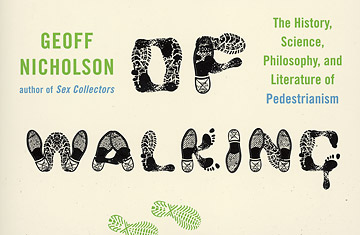
The Lost Art of Walking: The History, Science, Philosophy, and Literature of Pedestrianism
By Geoff Nicholson
Riverhead Books; 276 pages
The Gist: It's difficult to think of a simpler concept for a book than one about walking. It's one of the most pedestrian (saw that one coming, huh?) topics around. As author Nicholson writes, "Looked at a certain way, walking is the most ordinary, natural, ubiquitous activity. What could be more commonplace or lacking in eccentricity than the act of walking?" Nothing, right? False, as Nicholson demonstrates over a few hundred pages. In song, in literature, in wacky walking wagers, he breezily explores every possible cultural manifestation of perambulating.
Highlight Reel:
1. On the many, many words in the English language for walking: "So, if I have never cruised, catwalked, or streetwalked, I also hope I've never flounced ... Stormed, I think, is the preferred manly word here. Sometimes, less forcefully, I may have sloped off or stolen away. I have sidled, tiptoed, pussyfooted, perhaps even slunk. I have hit the street, pounded the pavement, worn out shoe leather, taken Shanks's pony, hotfooted it, legged it, strode out, loped, paced. So far I have never waddled ... I may well have promenaded, pedestrianized, peregrinated, ambulated, perambulated, circumambulated, hoofed, and locomoted ... I'm sure I've strutted, but I'm pretty damn sure that I've never swaggered."
2. On a particularly eccentric walker: "The most extreme Los Angeles walker I know is called Mudman, a persona of the artist Kim Jones. In order to become Mudman, Jones coats his body in mud, pulls a thick nylon stocking over his head, puts on a foam headdress, and then straps to his back a large lattice structure made of wooden slats, tree branches, wax, wire, tape, sponge, and whatnot. Sometimes he also wears a glove on his left hand from which a number of long wooden spikes protrude all the way to the ground. The effect is visually and conceptually compelling, especially if you see him walking toward you in a city street. Mudman is a living, walking sculpture."
3. On just one of a multitude of ridiculous walking bets: "Peter Radford, in his book The Celebrated Captain Barclay, recounts some gloriously eccentric pedestrian contests. One was devised by 'an unnamed Duke' who wagered a thousand guineas that he could find a man to walk the ten miles from Piccadilly to Hounslow within three hours, taking three steps forward and one step back."
The Lowdown: As rambling and leisurely as a walk through the English countryside, Nicholson's cultural history is confident in its lack of consequence. Essentially a collection of anecdotes, The Lost Art of Walking is buttressed by the sheer fun of said anecdotes — lists of walking-themed popular tunes and miniprofiles of the stroll-obsessed. It's a fruitful topic: walking is so essential to daily life that one can connect the act to almost every and any historical event or human endeavor — battles, expeditions, feats of endurance, or plain old human evolution as we move from crouched primates to upright homo sapiens. And while Nicholson commits that all-too-common sin of conflating his subject with his life — the book is as much memoir as history — he does so with the kind of wit capable of charming readers into glossing over his missteps.
The Verdict: Skim
